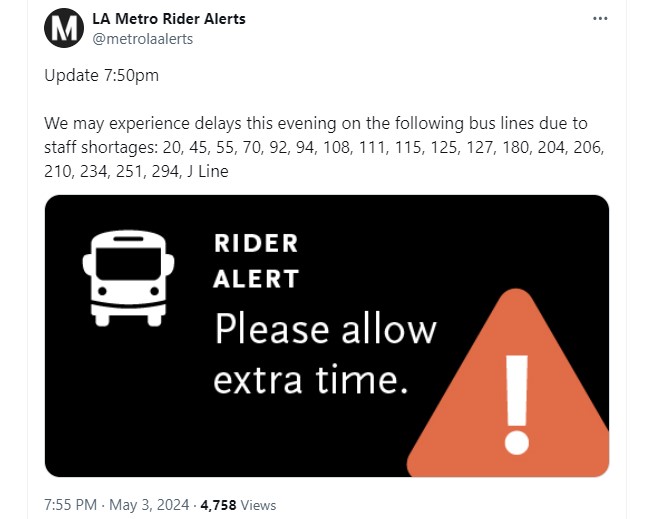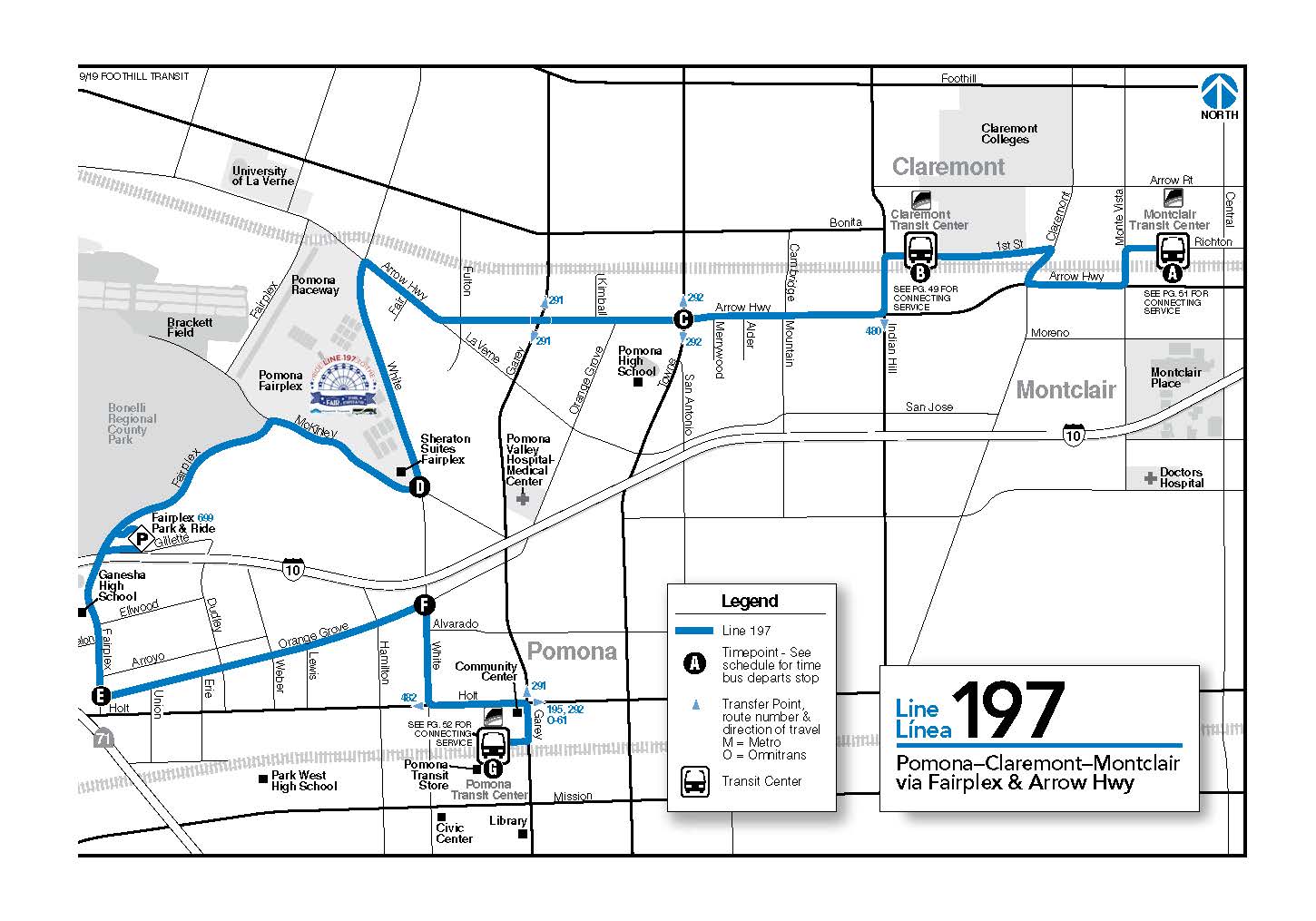Black and Brown Residents Speak to Urgency of Deep Systemic Transformation, Offer Insights Regarding Reinvestment
12:56 PM PDT on July 2, 2020

Gilbert Johnson, Lead Justice Organizer at Community Coalition (CoCo), speaks to the significance of this moment of rebellion while opening the nearly three-hour-long online discussion on the city budget priorities. CoCo had hosted the forum in collaboration with Black Lives Matter – Los Angeles and members of the People’s Budget L.A. coalition this past Saturday.
"We've been showing up to a lot of the recent city council hearings but we haven't really had the chance to speak," said Gilbert Johnson, Lead Justice Organizer at Community Coalition (CoCo) as he opened the nearly three-hour-long zoom call/facebook live discussion on the city budget priorities CoCo had organized in collaboration with Black Lives Matter - Los Angeles (BLMLA) and members of the People's Budget coalition this past Saturday. [The forum video is embedded at the bottom.]
The limiting of time for public comment at city meetings, the digital divide, and the distrust many in disenfranchised communities have for the institutions that have deliberately left them behind time and again have all compounded the challenge of making their voices heard.
And while there has been some progress made with regard to addressing the way communities are policed - L.A. City Council just approved a $150 million budget cut to LAPD, the LAUSD school board cut their police budget by $25 million, and motions have been put forth at council to study ways to divert non-emergency calls and to have the department of transportation take over traffic stops from police, to name a few - the discussions about what true reinvestment in the community looks like have been less specific.
So the organizers rallied their constituents to speak both on why it was so urgent to take bolder steps to defund police and on what reimagining public safety meant to them.
"We wanted to create this space to really elevate the stories and lived experiences of those people which we know are disproportionately Black and brown and indigenous folks and poor and working class folks," explained Johnson. "We want to provide space equity for folks that have been going through this for a long time."

Johnson recalled his own experience at age 15, when he and a friend got in a brief high speed chase with police after heading out to pick up some blunts. The officers told Johnson and his friend they'd been pulled over because they looked so young. Yet those same cops still felt entitled to use terrifying "brute force" with the youth, said Johnson, leaving him traumatized.
"We were little kids," he said.
In the intervening years, Johnson had had a number of negative encounters with law enforcement, including while incarcerated. But the violence of that early encounter, he said, was something that "I carry that with me to this day." And it was why "I'm gonna fight to the death of me to make sure my five Black children don't have to go through that. And y'all children don't have to go through that," he said.
What Johnson wanted to see instead, he said, was a public health approach to public safety - one that funneled investment into preventative work (e.g. youth programming, gang prevention, supportive housing and services, park equity) and in lifting up the community members that had been doing that work all along.
Getting that formula right is not easy, however, and requires deep engagement with the relevant communities, as other participants in the forum attested.
Mayor Eric Garcetti has repeatedly pointed to the Gang Reduction and Youth Development (GRYD) program as proof of how he has been ahead of the curve in investing in some of L.A.'s most marginalized youth, for example. But within the communities it serves, GRYD is also known for discouraging the kinds of collaborations or approaches to engagement that would allow interventionists to meet the wider range of needs youth have.
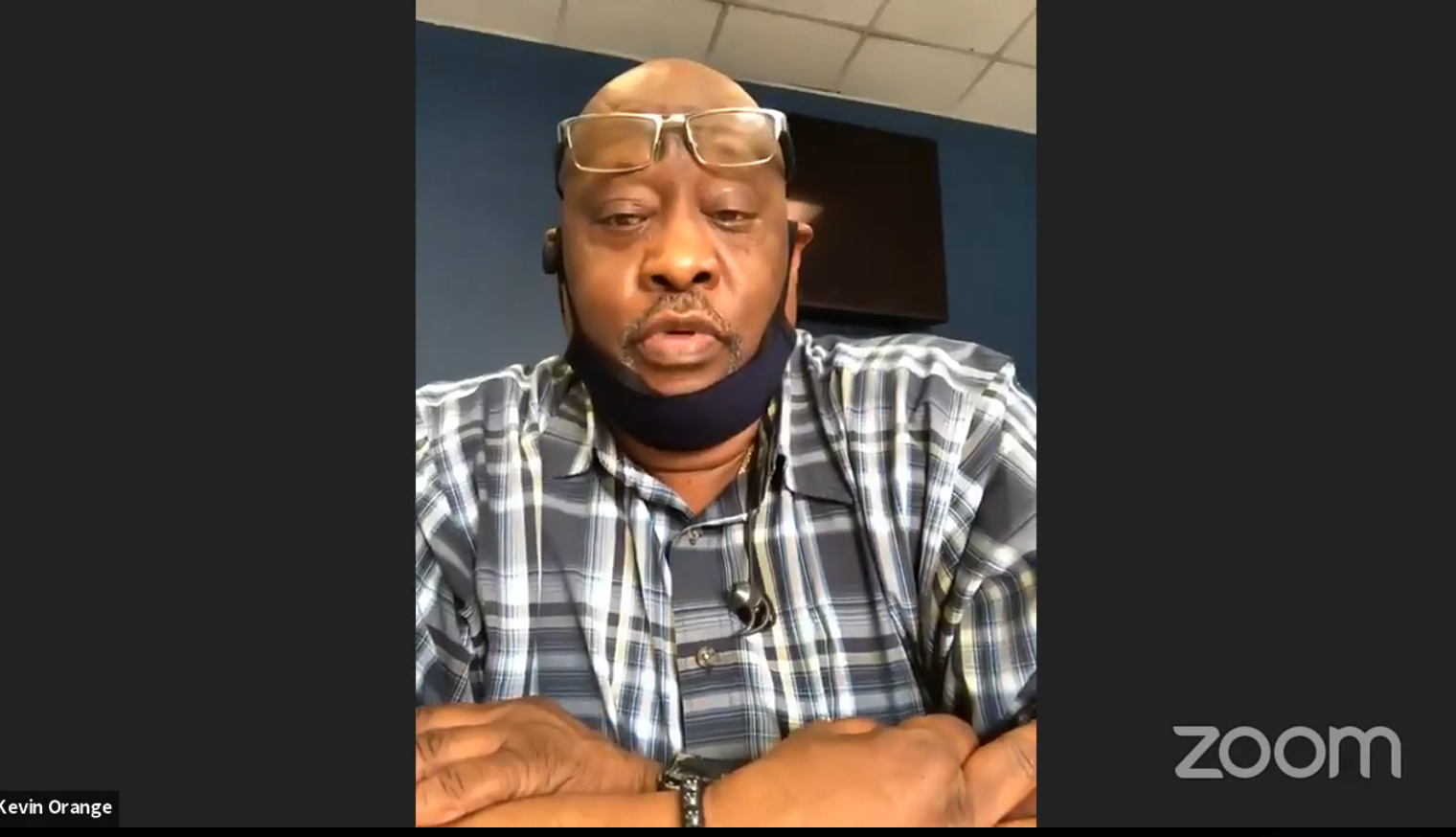
Kevin Orange - known to some as Twin (above) - has been doing intervention work in the Westmont area for the last fifteen years or so. He and other interventionists in the community had first come together informally to help youth get back and forth to school safely and to ensure students were able to learn in a peaceful environment. When Orange realized that funding was going to people and groups that didn't have that kind of commitment to the community or the lived experience that he and his peers did, he decided to put together his own organization.
Orange and his group, Advocates for Peace and Urban Unity (APUU), have since become an important voice in shaping public health advocates' understanding of the particular needs in the Westmont area. But getting those in power to understand the kind of relationship- and trust-building work interventionists have to do to be effective in their jobs has remained a challenge.
"We found out when you [don't have] unrestricted funding that it hampers you to give the adequate services that you should be providing the community," he explained. "If somebody comes through that door [of an intervention organization], they shouldn't be turned around without us able to help them at that moment... Once you let them turn around and walk out that door, they probably not coming back."
"Obstacles" built into the GRYD contracts, he said, made it hard for APUU to do community events or take youth on outings designed to round out their experiences and help them feel like youth again.
He was pleased that the momentum of this moment had opened up the possibility for much-needed funds to finally be directed toward youth programming, he said. But he also wondered whether the youth were going to be left behind once again. He had seen little effort by either the city leadership or grassroots activists to engage the youth or hear about their needs and aspirations. As a result, the youth felt like they couldn't trust anyone.
"They standing back and wondering how they're going to be used," said Orange. Were they going to be leveraged as justification for the demands made in the People's Budget and then forgotten about? Would law enforcement crack down on them with even greater force once this was all over? Would the city ever recognize the value of the lived experience of interventionists or pay more lip service to programs that shut them out?
For intervention to be able to play a real role in rebuilding communities, Orange concluded, activists - Black Lives Matter included - needed to pull up a chair and be prepared to dialogue with community members. And they needed to be prepared to hear that the funding priorities interventionists and the youth they served had might be very different from their own.
Speaking after Orange, long-time interventionist Skipp Townsend of 2nd Call expanded on how all-consuming intervention work could be, as well as how poorly understood his work was by those in and with power.
"A lot of what I do can't be documented," Townsend said.
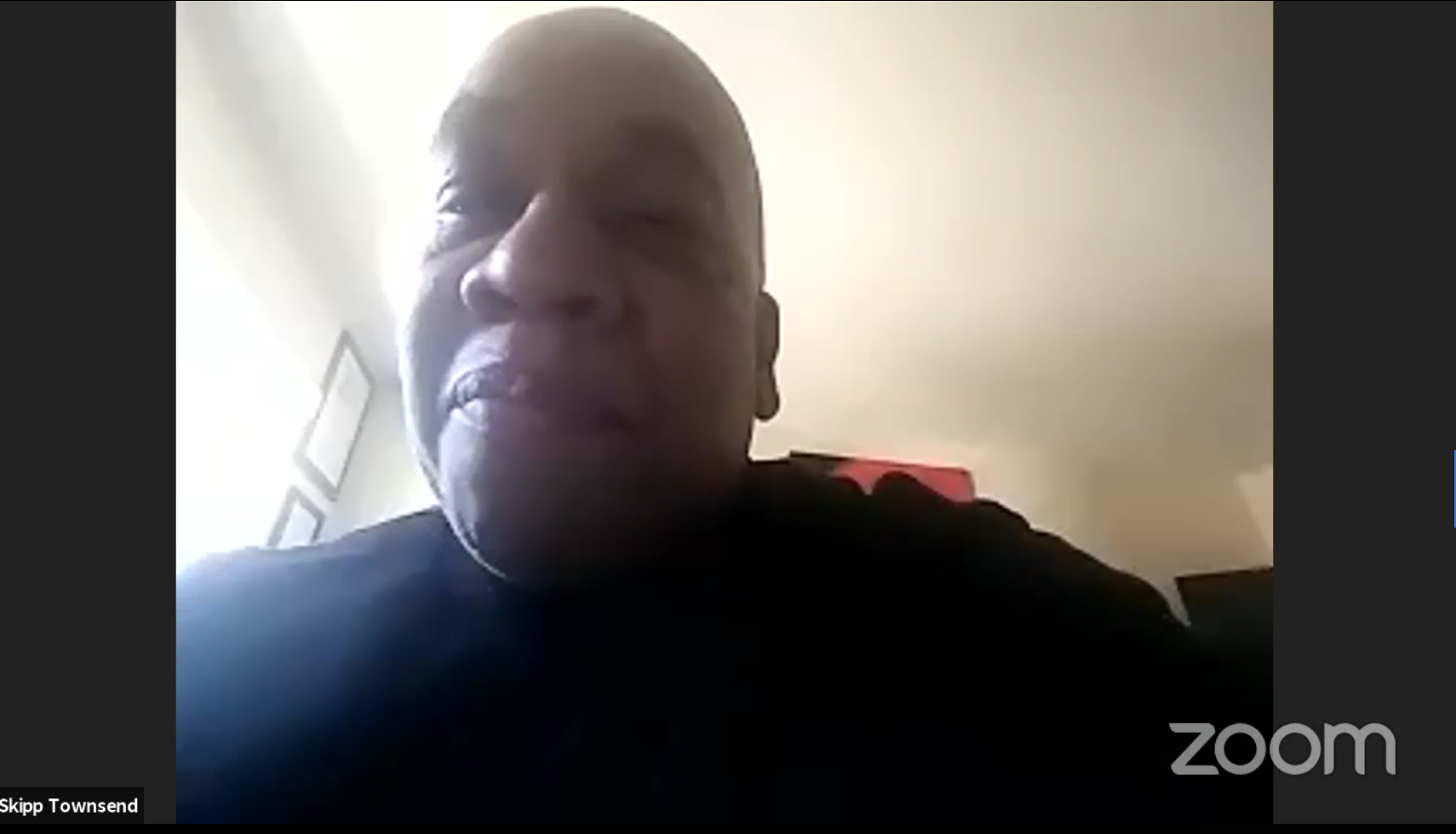
Prevention of bloodshed meant having to have boots on the ground before, during, and after a shooting. "We're out here when it's hot," he said.
To be able to exert leverage when it comes keeping a young man safe or from doing something that will only bring him more harm, for example, Townsend needs to have the time to get to know a young man and his people. In contrast, he explained, the city's approach to intervention work tends to prioritize the number of clients he has, their school attendance, or whether he got them a bus pass. Top-heavy organizations he labeled "poverty pimps" also undervalued his work by offering to throw $25,000 of a $2 or $3 million grant his way in the name of "partnership" while expecting him to do the bulk of the work.
It was time to tell the truth about these imbalances, Townsend said. That's not partnership. That doesn't value the work he does. And it's of no value to him.
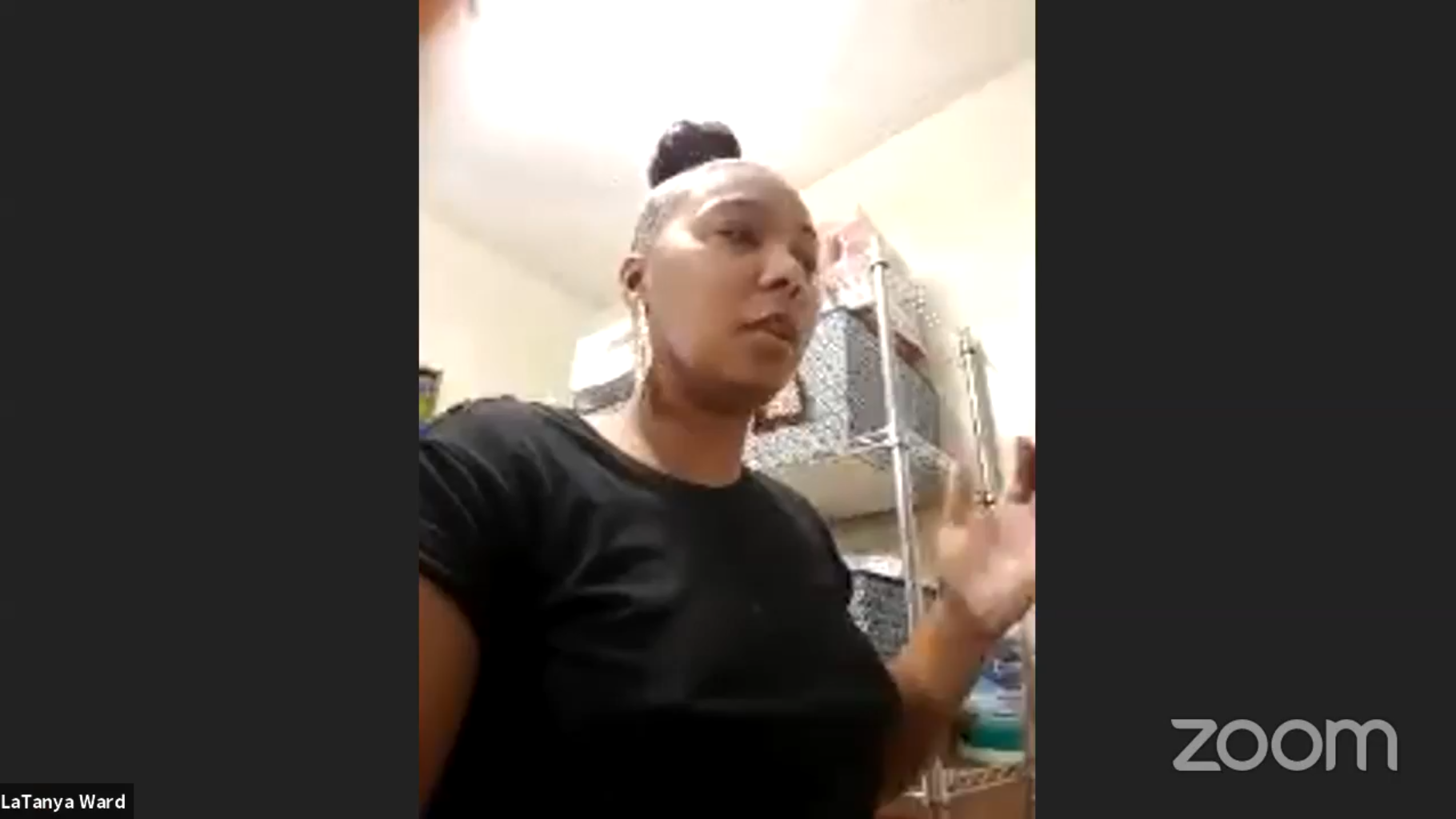
For LaTanya Ward, who came up as a gang member in The Jungle, this moment is particularly painful. Like both Townsend and Orange, she is afraid those with her background are going to be pushed aside yet again.
Because of the stigmas attached to gang membership, those with any kind of gang-affiliation are often viewed as a burden on their communities and left out of conversations around police brutality. Moreover, efforts to lift up victims of police violence that emphasized the person's "clean record" only helped validate the abuse leveled at those society considered to be "criminals," she said.
It dawned on Ward just how much she had internalized that stigma while she was prepping her comments for the forum. "I realized that I was trying to find [a story of a police encounter] that would, I guess ... warrant some sense of compassion because I fall into this group of people who are most abused by the police - being a gang member," she said, becoming emotional.
“A lot of my stories I didn’t want to share because I felt like I was doing something wrong to be abused by the police," she said. "But when I really thought about it, in a lot of those cases, I was just living where the f*ck my momma could pay rent at and hanging with my friends and being abused by...default.”
Much as Orange had in his remarks, she underscored the extent to which gang life was an outgrowth of generations of disinvestment, disenfranchisement, and repressive policing. "We are victims of this system...if not the most abused by this racist system," she said. "And it shows in our behaviors."
Ward herself had been instrumental in organizing the historic gathering and peace march that brought together hundreds of gang members - some of whom had been rivals for four decades - in the wake of Nipsey Hussle's passing in 2019. And like Townsend, she is convinced that more needs to be invested in not only lifting up folks with her lived experience but ensuring that they are present and trained to be leaders "at every f*cking level" of the intervention infrastructure - "not just the ground level."
The toll of repressive policing
A number of people who spoke Saturday testified that they had far more faith in the interventionists - and sometimes even the gang members - than the police.
But their stories also spoke to the fear they had of law enforcement - the knowledge that the encounters would always entail some form of disrespect, intimidation, trauma, or violence - and the urgency of a new safety paradigm where they could finally get the service and protection they deserved.
Whether it was Vanessa Bailey speaking of the night police crashed through her front door and pointed their weapons at her (they were supposedly looking for a burglar, but she says they never apologized or attempted to fix what they had broken). Or Latia Suttle, whose father was killed by police who responded to a nonviolent 911 call. Or Verneen Mincey whose brother's death by chokehold in 1982 finally led to LAPD's moratorium on the practice (below). The conclusions they reached were the same: "We cannot reform a system that is deeply rooted in the dehumanization and the suppression of Black and brown communities," as speaker Arturo Flores put it.
Plus, they had already watched the LAPD and the city go down that route many times before, as James Thomas, pastor of the Living Word Community Church, noted, and been disappointed every time.
"This talk of 'reform' is all about politics," he said, making his case for defunding police. "It's nothing to do about what is best for our people."
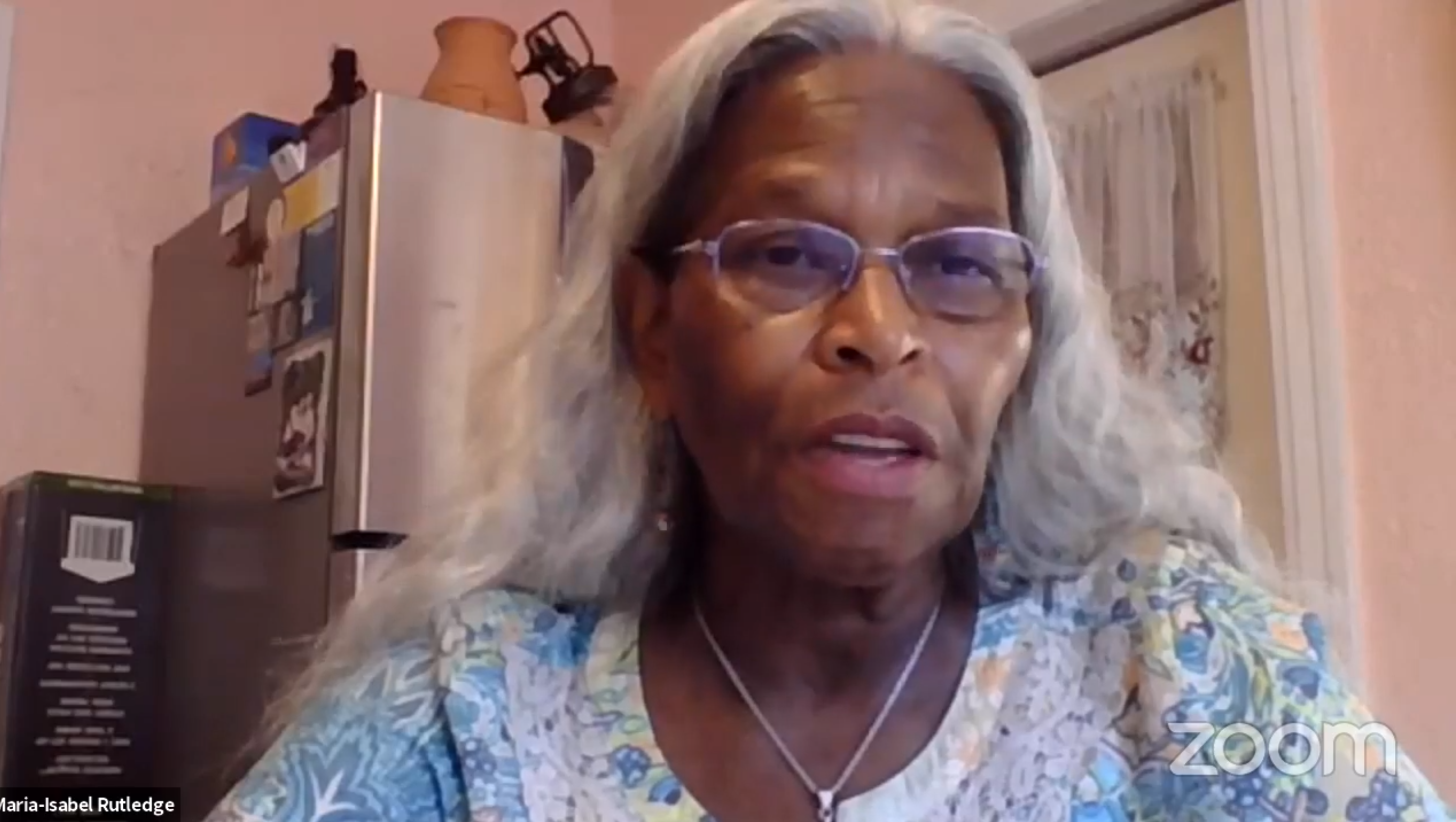
Maria-Isabel Routledge, a resident of the Vermont-Manchester community for 60 years, was one of several mothers who spoke about how much they feared the day that their teen sons would have an encounter with police.
Routledge had tried to mitigate her fears by joining the local community-police advisory board. That way, she explained, she might at least have an officer who could see her as a community member if her boys ever got picked up. But the fact that there never seemed to be any repercussions for police who harmed community members made her feel that positive change was unlikely if done incrementally.
Organizer Carlos Cázares' experiences with law enforcement had brought him to the same conclusion.
He said he was just five years old the first time he saw his mother put in handcuffs (she had advocated for the arrest of a hit-and-run driver). He would find himself handcuffed for the first time six years later, at age eleven, when he and two other friends were detained for playing with water balloons in the street.
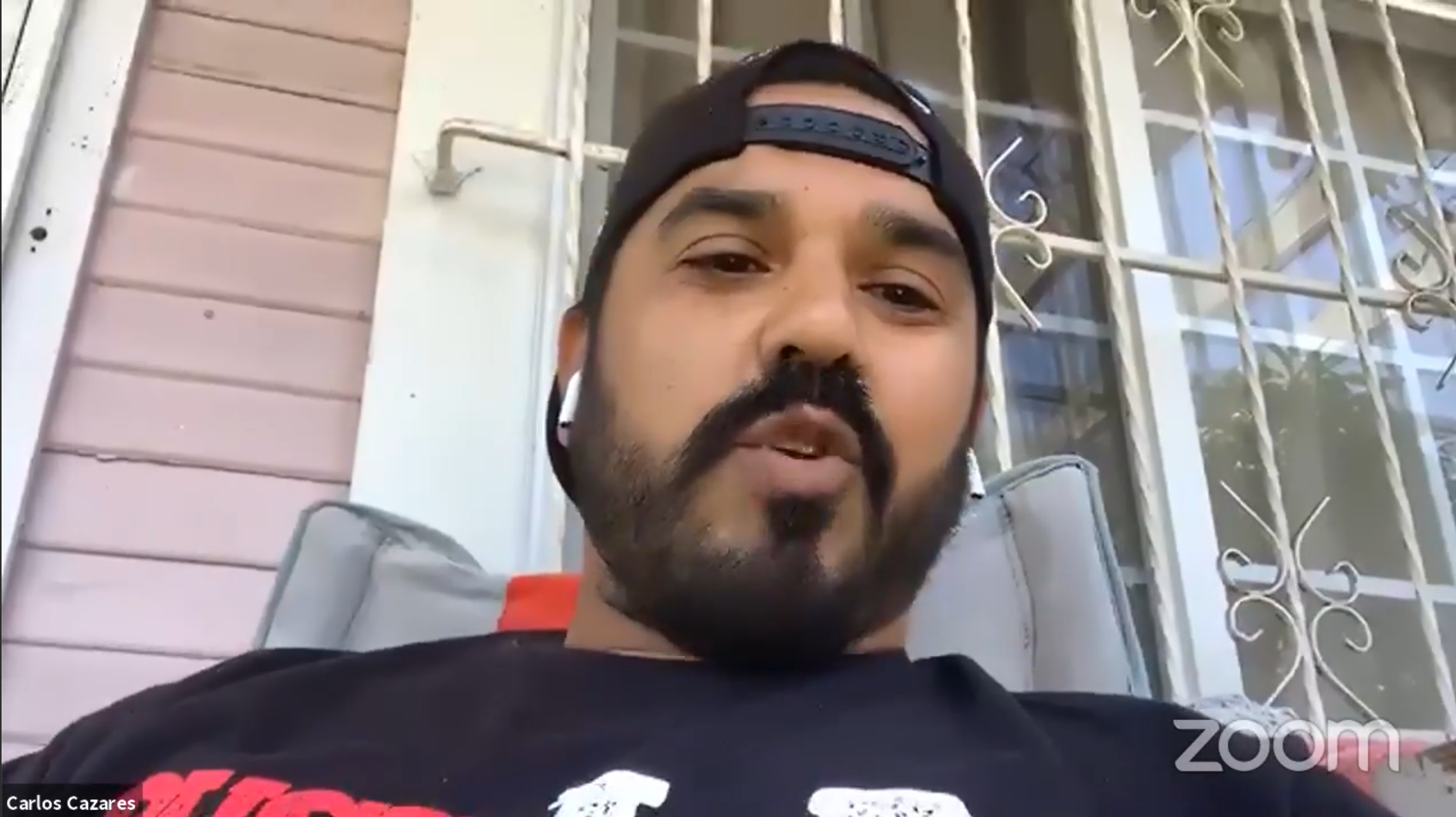
Things didn't get better as he got older. He saw more police officers than counselors during middle school and high school. Over the course of his undergraduate career at UCLA, officers stopped and questioned him five times. As a middle school teacher, he found himself forced to uphold the same system that he'd been oppressed by as a kid. Finally, as an organizer, he said, he’d sat in on a conversation where a police officer had admitted to the prioritization of the policing of Black and brown youth in South Central.
“I and many others are sick and tired of living in and being a product of a police state," said Cázares. "We’re done paying for an institution that produces racism, violence, and poverty. We are done talking. It’s time to put money where the people are at."
For those who had been incarcerated, or had had loved ones who were incarcerated, that meant directing it toward supportive services addressing trauma and mental health.
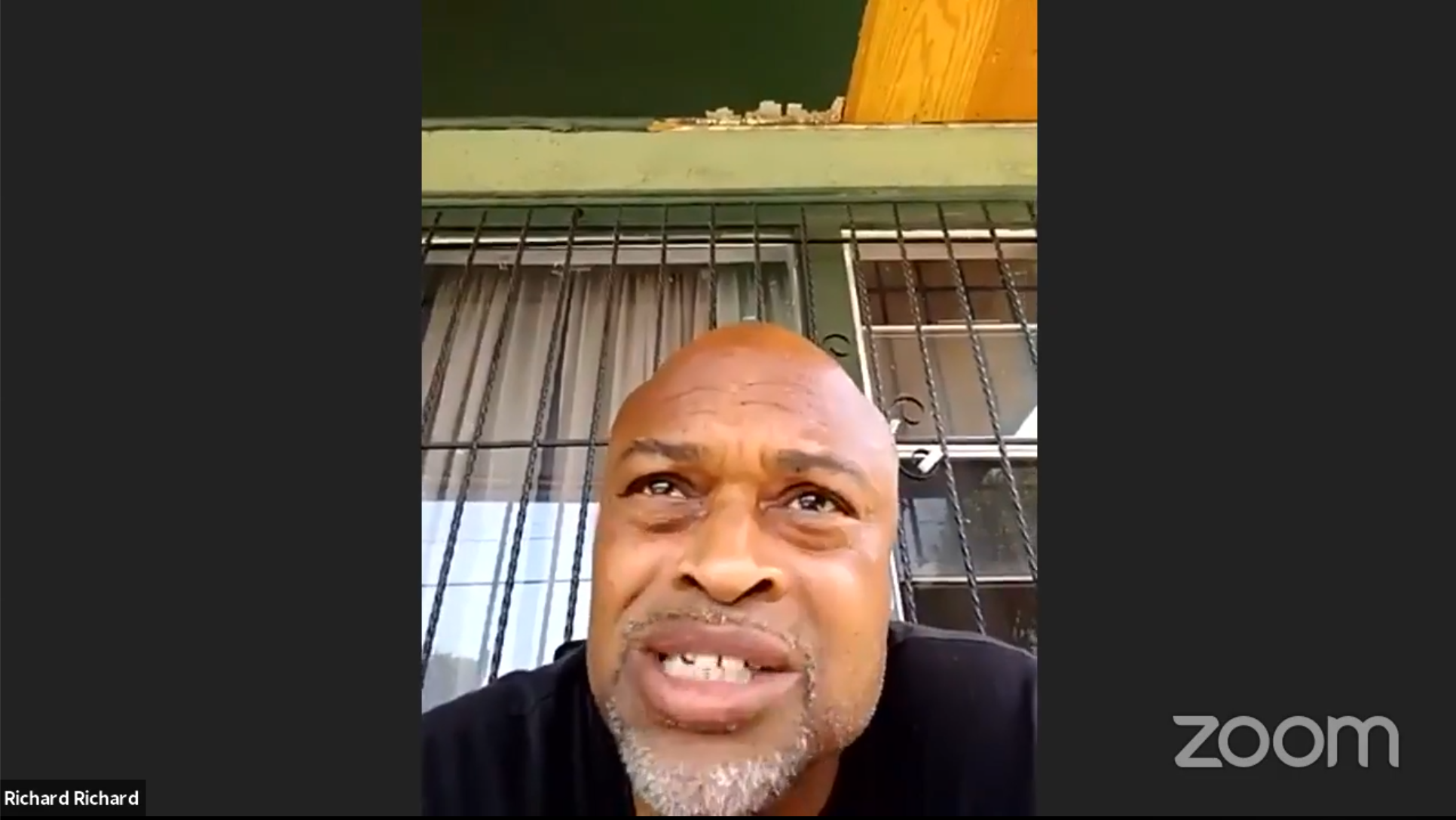
Speaking frankly about having done 43 1/2 years in prison for murder when he was a juvenile, Richard said that he had quickly learned that just about everyone locked up with him had experienced some form of trauma. And that many would go on to suffer additional traumas while incarcerated, himself included (his jaw was broken by guards, among other things, he said). It was in that environment that he had "had to learn and discover who I was as a person" and, despite not getting proper treatment or care while in prison, still figure out a way to be ready to be a productive member of society once he came home. The failure to give folks adequate assistance both helped land folks in prison and then made it more likely they'd go back in once they got out, he said.
Or they would never make it home at all, like Valerie Stacker's bipolar son who begged for proper medication from prison doctors before eventually dying of a fentanyl overdose while incarcerated in 2015.
Or they would continue to fear persecution from the police even after getting out of jail and getting themselves back on track, like Angélica Sánchez. Though she had been clean for two years and had gotten a job with Homeboy Industries in the hopes of putting her gang past toward building a better future, she said, her child had still been taken away from her. She was still "a criminal in their eyes," she said.
"We are definitely tired and fed up with the PTSD and the trauma that all of us Black and brown folks go through in the community, said Carlos León, Lead Community Organizer with CoCo, who had spoken to the troubles he had had with police as an undocumented youth. "We need care not cops...We need to step together and be apologetic and go all the way. We're not trying to reform we're trying to fully transform and get what our children need."
See the full forum here.
Sahra is Communities Editor for Streetsblog L.A., covering the intersection of mobility with race, class, history, representation, policing, housing, health, culture, community, and access to the public space in Boyle Heights and South Central Los Angeles.
Read More:
Stay in touch
Sign up for our free newsletter
More from Streetsblog Los Angeles
This Week In Livable Streets
Bike Month continues, Metro 91 Freeway widening, Destination Crenshaw, Culver City Bus, Santa Monica MANGo, Metro bike lockers, Metro Sepulveda Transit, and more
San Fernando Valley Bus/Bike Updates: G Line, Roscoe Bus Lanes, Laurel Canyon Bike Lanes
Short newly protected bike lane on Laurel Canyon Blvd, extensive NSFV bus improvements under construction this month, and scaled-back G Line plans should get that project under construction this summer
No, L.A. City Does Not Always Add Required ADA Ramps During Resurfacing, But They Should
StreetsLA GM Keith Mozee "Any time we do street resurfacing, it is considered an alteration, which requires ADA ramps to be installed."


